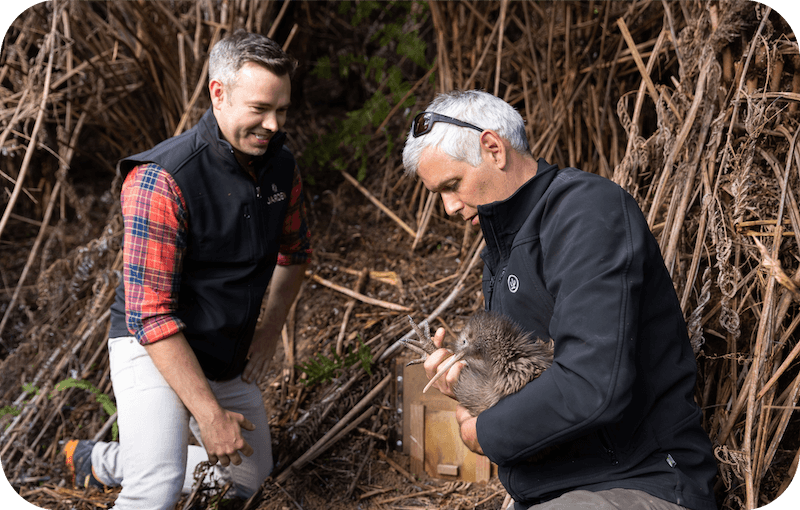Following years of hard work, 63 wild kiwi have been released in Wellington. Capital Kiwi’s head of operations, Peter Kirkman, updates us on how they’re going and the challenges they’ll face.
Following five years of work built on partnerships with landowners, iwi and local communities, 63 wild kiwi are now roaming the hills of Wellington. The project has a DOC permit to release nearly 200 more.
Kiwi can range large distances and, as expected, some are roaming from their Terawhiti release site. A pair was encountered last week by a mountain biker in Mākara Peak, footprints have been photographed in Mākara Cemetery, and one has been located near Karori’s Skyline Walkway. It’s a matter of time before locals in the western suburbs hear and encounter kiwi.
In more than two decades of working to protect threatened species, from the Subantarctic islands to Northland, one of the concerns I’ve developed is the gap between the reality of successful species conservation and what people can believe it to be.
Recently the nation was outraged at the welfare of a kiwi at a Miami Zoo, but we can turn a blind eye to the harsh reality at home: every kiwi chick that hatches in an area with no protection against introduced predators is near certain to be killed, most probably by a stoat.
From a population of millions, there are now an estimated 70,000 kiwi left in the wild, and where there is no predator control, populations are declining towards extinction. Kiwi are tough, resilient animals, and an adult kiwi can live 40-plus years, but the issue is that once an adult dies there are typically no heirs.
The Capital Kiwi Project has built on 2,000 existing predator traps set up across Wellington by community conservation groups and reinforced and extended those networks with a further 2,600 traps, making a grid of 4,600 that covers 24,000 hectares of land stretching from Red Rocks to Porirua. As one of the first landscape-scale projects supported by Predator Free 2050 Limited, together we have reduced stoat numbers to very low levels.
We have removed thousands of predators, but some stoats still remain. Mainland eradication is an unmet challenge: unlike an island, there’s no moat. While there is a lot of innovative research and development underway across New Zealand, we currently lack the technology to identify and remove individual stoats.
We’re using a proven trap network design at a density that has delivered kiwi recovery in other areas. Our monitoring shows that the remnant stoat population is consistently low enough to allow for kiwi release. At just over 1 kg, which it reaches at around 10 months old, a kiwi chick is able to fight off a stoat. Roughly 20 percent of kiwi chicks – one in five – need to reach this weight in order to grow a sustainable wild kiwi population.
That might be challenging for people to hear. We expect to do much better than one in five, based on our monitoring results, but we will lose kiwi chicks to predators. And just as they always have, some kiwi will have accidents and die through misadventure. Also, around half of all kiwi eggs fail to hatch, which is largely due to infertility.
All conservation projects require tough choices. One response to chick predation involves uplifting eggs and hatching and rearing chicks in predator-free environments before returning them to the wild when they reach stoat-proof weight. On a bird-by-bird basis it is a successful strategy, but it is intensive and expensive.
Another approach is to leave the parents to raise their chicks naturally, and to deliver the predator control required to enable sufficient chick survival to grow a population. This is Capital Kiwi’s approach. It’s hands-off and trusts in a method that is proven and evidence-based. The aim is to create a large wild kiwi population that lives alongside people, where kiwi are free to range and parent as naturally as possible. (Over the coming breeding seasons, a portion of the Capital Kiwi population will be monitored to measure chick survival rates).
As birds establish territories and pair up, we expect there to be kiwi eggs and chicks on our hills. The trap network should provide these chicks with a vastly improved chance of survival.
There will be some casualties with this approach and not everything will go our way all the time. Wellingtonians need to be prepared for this and to take a long-term approach.
The population we’re now building is fledgling and it requires us all to care for it.
With its big claws, an adult kiwi can fight off most threats except ferrets and dogs. We are fortunate to currently have no ferrets in the project area, and with our trap network design, we intend to keep it this way. Uncontrolled dogs are now the single biggest threat to Wellington’s adult kiwi. Even a small pet dog can kill a kiwi.
Looking after kiwi as they reach the city’s western fringe will require changes in behaviour from dog owners; for example, undertaking avoidance training where appropriate, observing on-lead bylaws, and reporting wandering dogs. From experience, once communities understand the need, they come onboard to protect kiwi.
We are confident that, with the support of the Wellington community, we will establish a growing kiwi population. As with the 4,600 traps, the strength is in the network.


